A Hindu Wedding – Fun, Colourful and Sacred
An Indian marriage is not just a union between the bride and groom, but a union between families. It’s not just a time of romance and parties, but of sacred matrimony bonded by rites and rituals, by blessings and presence of either a Holy Bible, or Gods and Goddesses.
And though all may seem the same to foreigners, to any local Indian, the rituals and rites are quite varied according to beliefs, castes, and regional customs.
The following story is about a Hindu wedding of Dave Malhotra and Sheetal Pawa.
Sheetal and Dave have known each other since 2001, when Sheetal was 14 and Dave was 17; young, wild, but not free. The only way that they could communicate, since they were both in different boarding schools, was through writing love letters.
Depending on who you ask about who fell for whom first, you will not get the same answer. But one thing they can agree on is that during their 7 years of friendship, they had a crush on each other all along, a crush that only grew stronger when they were both in the right place at the right time…with the right person. What happened next? Magic happened.
On the beautiful night of December 1st, 2008, when 2 stars and a crescent of the moon formed a smiley face on the sky, they had their first romantic date. This was when they decided to take their relationship to the next level by becoming exclusive.
The couple had been dating for 5 and a half years before deciding to become officially involved as one family. Through the five and a half years of their relationship, they had their ups, and definitely downs, but love and commitment helped them hold onto one another. Finally, on 12th December 2012, Dave proposed to Sheetal, and on Sheetal’s birthday, 29th September 2013, Dave planned a surprise birthday party for her with her friends at Zense, Central World, where he later gave her a promise ring.
Sheetal and Dave’s families met, took trips to Pattaya City and decided to meet with the Hindu pandit (Hindu holy men) at the Mandir (Hindu temple) to finally set the engagement and wedding date on 14th and 20th June 2014, respectively.
Getting Ready: Indian weddings, while being among the most fun and exciting, are also the most detailed where preparations could take as long as six to twelve months – starting with shopping. The shopping can be done by the bride and groom’s families together, or each family shopping separately. However, Sheetal had travelled to New Delhi to do her Daaj (the bride’s wedding shopping), convinced that Dave would be doing his Vari (groom’s wedding shopping) with his family. But Sheetal was given another surprise when Dave showed up on Valentine’s Day in New Delhi with flowers.
Daaj and Vari are considered as necessary shopping for suits, saris and lenghas, which are traditional Indian clothes that the bride has to take with her to her husband’s house, including jewelry that is given to both the bride and groom from both sides of the family. Sheetal selected Indian clothes for herself and Dave, including the jewelry she needed to wear.
The couple returned to Thailand after an exhausting but fun shopping spree in India to continue with their wedding preparations, which is no easy feat. There were hotels to visit and reserve, hotel decorations, flowers, drinks, dishes and beverages to order, a pre-wedding photo-shoot to plan, selection of media during the wedding, preparing invitation cards, fruits and chocolate baskets, listing the number of relatives and friends to invite – the list goes on and on. There is a saying amongst the Indians in Thailand: “Preparations for an Indian Wedding are never complete until the wedding itself is finished.”
After both parents of bride and groom agree to the wishes of their son and daughter to be married, the auspicious day is chosen by the Pundit, or the knowledgeable and honorary priest.
Various preparations are underway thereafter, leading to the big day.
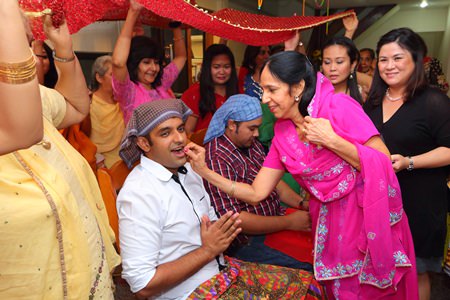
At Home – Henna
A few days before the wedding, small ceremonies and celebrations take place separately in homes of the Bride and Groom; Mehndi or Henna decorations are worn on the hands and feet, stomping on the rice pot for luck, and bathing in yogurt and turmeric for a healthy wedding glow are part of the tradition, as are dancing, singing, and feasting.
This joy and madness could go on from 3 days to a month before the actual day arrives.
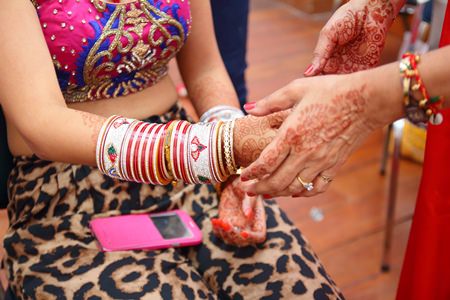
Wearing of Bangles
On the morning of the wedding day, the pundit arrives at the bride’s house to officiate Chura (wedding bangles of red, gold, white colors worn by brides) ceremony.
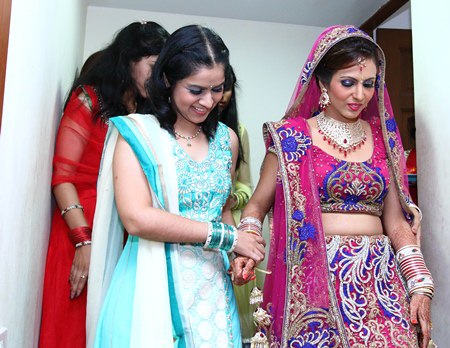
At the Temple – Bride gets ready
The bride is then taken to the Hindu Temple by her Sarbali, or the maid of honor, to get dressed and prepare for the marriage ceremony.
The bride is dressed in heavily embroidered lengha with silver and gold linings, while her jewelry consists of heavy diamond, gold and silver necklace, earrings and Tikka.
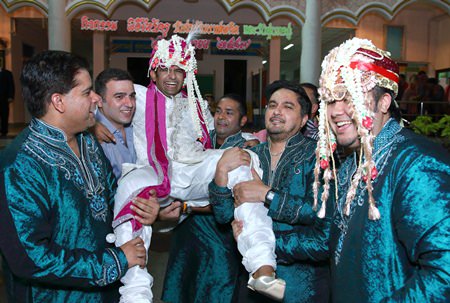
Groom’s Family Arrives
Meanwhile, at a certain auspicious time, the groom’s Baarat arrives. Baarat is the procession that the groom and his best man arrive with, on a horse, an elephant, a carriage, or a Tuk Tuk, whichever is convenient and available, accompanied by music, drums, and dances by the groom’s family and friends.
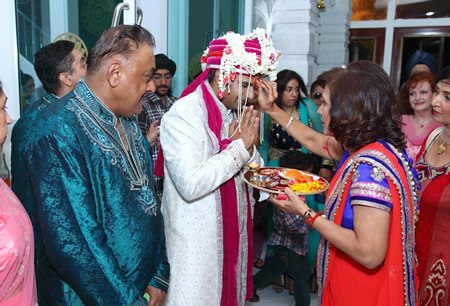
Groom reaches the Main Floor
As the groom reaches the main floor, the bride’s mother welcomes him and his family with Indian delicacies. The ceremony continues with Milni (the members of bride’s family present gifts to males of the groom’s family)
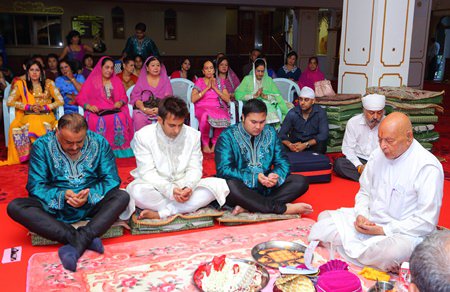
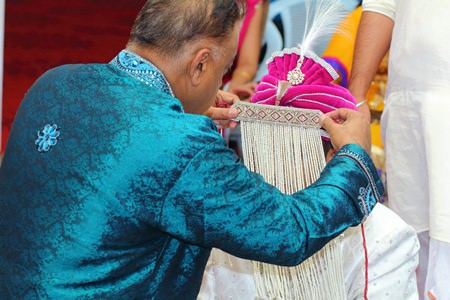
Sehrabandi
The groom’s family joins in prayers with the Pundit, and the groom’s father performs the tying of the ‘Sehra’ on the groom and the best man.
Since a Hindu marriage ceremony is consecrated in accordance with the Vedas, the sacred scriptures, throughout the ceremony, the Pundit or the honorary priest will recite Vedic verses in Sanskrit, the ancient Indian language.
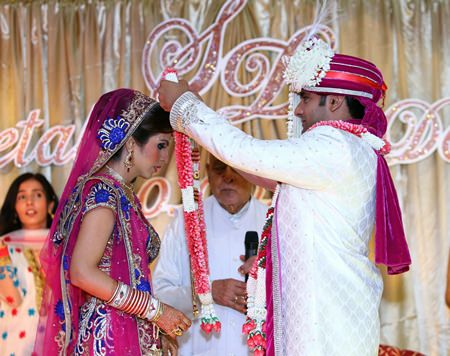
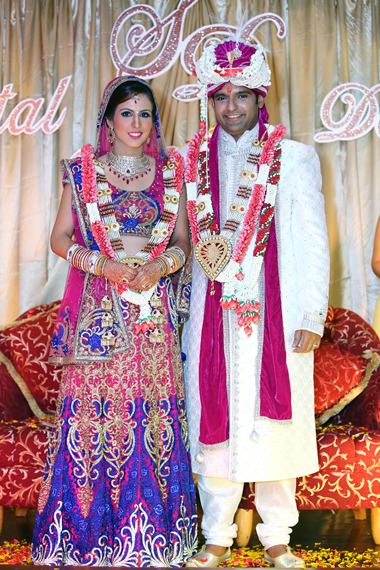
Jaimala Ceremony
The bride is led to the stage to be seated next to her fiancé for the Jai Mala ceremony, where decorated garlands are put on one another, followed by dinner, and ultimately the signing of official Wedding Book.
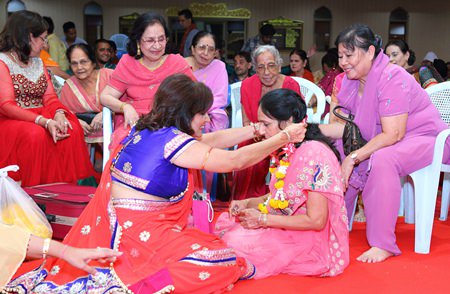
Ladies’ Milni
After dinner, the families and friends move on to proceed with the Ladies Milni.
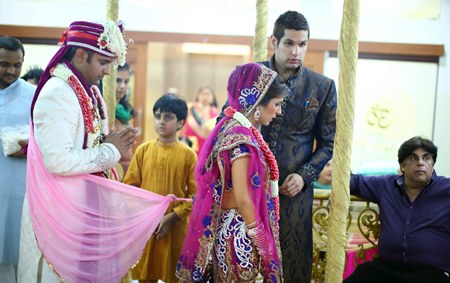
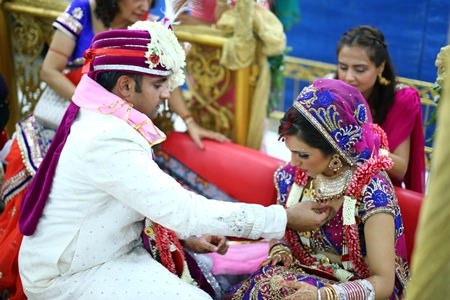
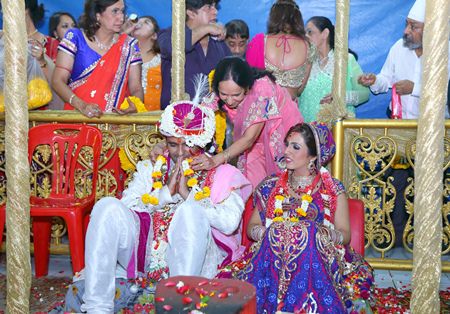
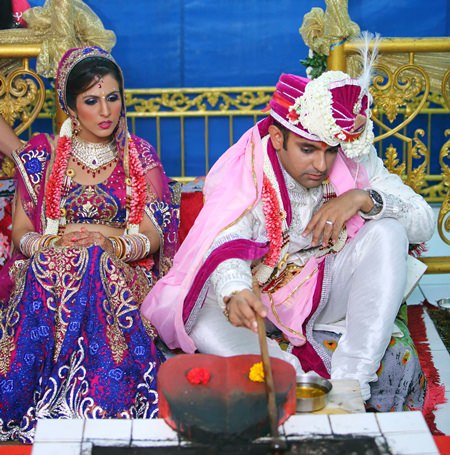
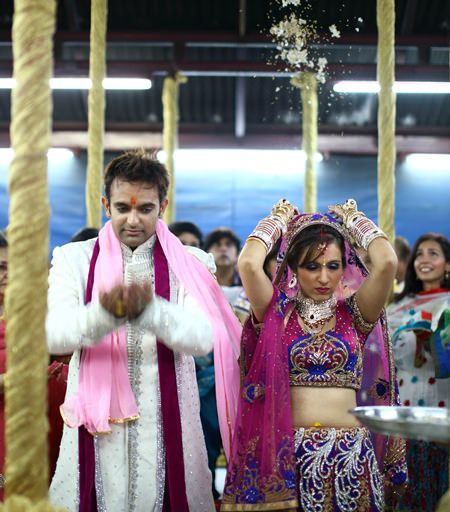
At the Shaadi
By midnight, the couple would finally move to the Shaadi (wedding) ceremony, and the following is a compilation of what a typical Hindu wedding looks like:
Var Aagamana (Welcoming the Groom)
The groom arrives at the entrance of the wedding canopy (Mandap), accompanied by family members and friends. Auspicious materials are carried along for good luck. The prospective mother-in-law performs a welcoming ceremony and will playfully try to grab her son-in-law on the nose. This tradition reminds the groom that he has come rubbing his nose at their door asking for their daughter’s hand in marriage. The ceremony signifies an attempt to drive away evil spirits. The groom then approaches the marriage altar.
Ganesh Puja (Prayer to Lord Ganesh)
All auspicious ceremonies begin with a prayer to Lord Ganesh requesting him to remove any obstacles which may arise during the ceremony.
Kalash Puja and Punyaha Vachan (Prayer to Lord Varuna)
Kalash Puja is performed to Varuna, Lord of the Water, to purify the premises.
Var Puja (Paying Respect to the Groom)
Mangalashtak (Request of Blessings)
The priest requests all the planets, Gods, and Goddesses to bless the couple with a happy and healthy married life.
Kanya Aagaman (Arrival of the Bride)
The bride is led by her father to the marriage altar. At this time an Antarpat, or white cloth curtain, separates the bride and the groom.
Varmala (Garland)
A loop of white cotton wound 24 times, symbolizing different characteristics and virtues of human life, is placed around the shoulders of the bride and groom. The threads bind the two together to fulfill their roles fully and sincerely.
Hasta Melap (Joining of Hands)
The priest joins the hands of both together while blessing upon them all good wishes for a happy and healthy wedded life. The priest ties the bride’s ‘chunni’ to the groom’s scarf. This signifies that they have been tied to each other in body, mind, and soul for the rest of their lives.
With the priest presiding, the bride’s parents pay respect to their son in law by washing his feet with milk and honey.
At this time, the bride’s cousins will try to steal the groom’s shoes and since traditionally the groom must leave the wedding with the same pair of shoes that he entered with, he has to get his shoes back at whatever price. Negotiations start and if he’s lucky he will not have to break the bank for his pair of shoes.
Kanya Daan (Giving the Bride Away)
The bride’s father requests the groom’s father to accept his daughter into their family. The bond is tied between the two families for seven generations.
Mala Arpan (Exchange of Garlands)
The bride and groom exchange flower garlands. This gesture symbolizes the unification of their hearts.
Laja Homa (Offerings to the Fire)
The bride’s brother gives the couple some rice, oats, and leaves to throw into the fire. This signifies that the couple is willing to sacrifice all of their worldly possessions behind for a more rewarding blessings from the God.
Mangal Phera (Holy Steps around the Sacred Fire)
The bride and Groom circle the sacred fire four times, signifying the four basic human goals of Dharma (virtue), Artha (wealth), Kama (family), and Moksha (enlightenment). The priest bestows blessings for a long, happy, and healthy marriage.
For a more traditional wedding, the couple may take 7 rounds around the Agni Homam (sacred fire) in a clockwise direction signifying the seven goals in marriage life. The bride and groom take turns in leading the walks, signifying equality in marriage through happiness and sorrow, in addition to the seven vows.
Sapta Padi (The Seven Vows)
The groom helps his bride to touch seven betel nuts on rice with her right toe while they recite each of the seven vows: “We will respect each other. We will care for each other. We will be patient with each other. We will be honest and faithful to each other. We will be together in sorrow and happiness. We will travel this journey of life with love and harmony. We will keep our family happy, healthy, and strong.”
Mangalsutra (Sacred Necklace)
The groom promises lifelong protection by offering a Mangalsutra (sacred necklace) to his bride and applying Kumkum (red colored powder) on the crown of his wife’s head. These two gestures signify the mark of a married woman and serve as a symbol of the husband’s love, integrity, and devotion.
Although not a traditional Hindu custom, the couple may exchange rings at this time.
Kansar Bhojan (First Meal Together)
The ceremony is culminated by the couple sharing their first meal together when each offers Kansar (a sweet made from crushed wheat) to the other.
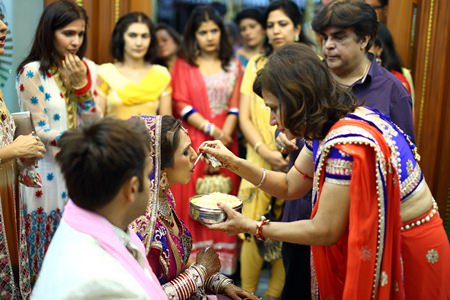
Aashirvaad (Blessings from the Elders)
Finally, before the newlywed couple leaves the marriage altar, the priest blesses the couple on behalf of the Gods and Goddesses with everlasting happiness. The couple then receives blessings from family members and friends.
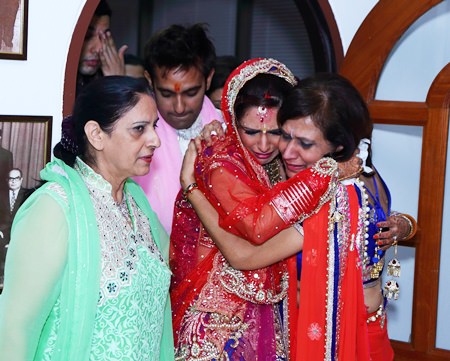
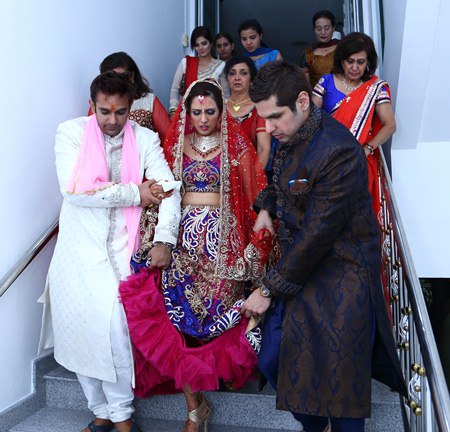
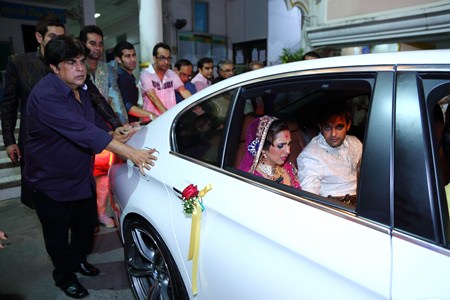
Doli (Giving away of the Bride)
The bride’s family escorts the bride to the groom’s decorated car, or in the old days, a carriage that takes them to their new home.
This is a very emotional time for the bride and her family, as traditionally, the bride is now totally in the care of her husband and his family, and no longer of her parents’. Also, in remote places in India, this could mean days or months of travel, and so it would be a long time before she will get to see her family again.
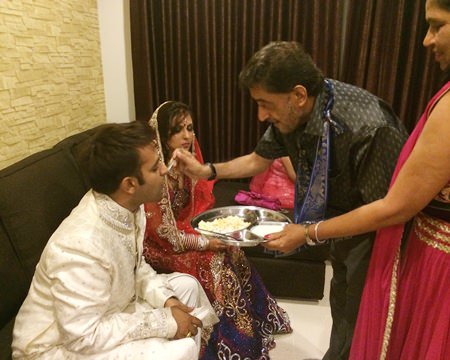
Welcoming the bride
Though not exactly part of a typical Hindu wedding, but still well practiced in Indian rituals to welcome the new bride, some cooking oil is poured on the sides of the door and a pot of rice is placed for her to kick as she walks into her new home. This signifies that this new home shall have plenty of wealth and food.
The couple is offered sweets by her new family members, hugs and welcomes follow before finally releasing them to retire to their own awaiting honeymoon suite, daintily decorated with sweet fragrant flowers.
The couple is now married and a new blessed life begins for both of them.




